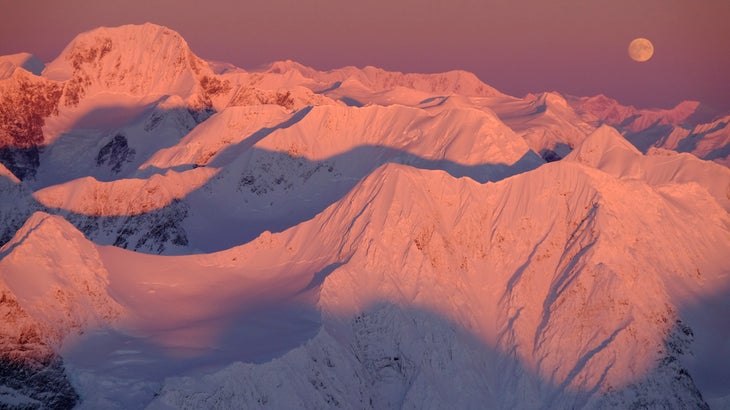Products You May Like
Curiosity is the root of adventure. You let it lead you to the next switchback, the next view, the next trailhead. Likewise, it probably drives you to ask questions—about everything from the color of the sky to why your knees are killing you. We gathered the most burning queries and spent weeks scouring textbooks, deciphering diagrams, and grilling experts for the answers. The result? Dozens of factoids that will impress even your most well-read hiking partner and leave you with a new appreciation for our world. (Here, we answer questions about nature. Check out our deep dives into gear and hiker physiology.)
Most mountains form near the edges of continents or in volcanic regions. How did the Rockies show up in the middle of nowhere?
The textbook answer is that an oceanic tectonic plate got pushed really far underneath the West Coast. As the theory goes, “the slab was basically grazing along the bottom of the North American Plate, and—much like if you push a rug along a slippery floor—the plate started to ripple up in front of where it was being pushed,” explains Craig Jones, professor of geological sciences at the University of Colorado Boulder.
“That’s a very nice idea, but there are some inconsistencies with what we see on the ground,” he says. Instead, Jones’s lab doesn’t think those shoving forces are what created the Rockies, per se. Instead, they think the sinking plate coupled to the upper plate while it descended. Meanwhile, the flow of magma between the plates created strong suction forces that pulled the plates together. The sinking plate was tugged upward and the upper plate was tugged downward, which ultimately left a hollow that masses of rock could tumble into. To get an idea of how this works, imagine you have a trampoline covered with tennis balls. Now, if you crawl under the trampoline and pinch the middle of it and pull down, the tennis balls will roll and pile up in the hollow you’ve created. That’s what Jones thinks happened—geological stress below the continent caused the plate to dip, inviting tons and tons of rock to slide inward and pile up over millions of years, creating the mountain range.
Can trees actually communicate?
Believe it or not, trees are regular chatterboxes. They release chemicals into the air, transmit electrochemical signals through their roots, and exchange carbon and nutrients via vast networks of subterranean fungi. That’s according to Suzanne Simard, a professor of forest ecology with the University of British Columbia and author of Finding the Mother Tree: Discovering the Wisdom of the Forest. Simard also suspects that trees send signals via the “gazillions of species” of bacteria and microbes in the soil. But what are they talking about? “There’s information in these chemical compounds that can tell neighboring trees whether or not there are enemies, like an herbivore eating the leaves or a pathogen that affects the tree,” Simard explains. “The neighboring trees detect these compounds, and they’re able to increase their own defense against whatever the threat is.” Trees are also able to detect the species and kinship of each of their neighbors—and preferentially send nutrients to their offspring. But it’s not all butterflies and rainbows: “There’s collaboration but there’s also competition,” Simard explains. “Some communication is benevolent, and some is malevolent—just like human language.”
How long does poop take to decompose in a cathole?
One to three years (longer in cold or dry environments).
How does talus form?
Talus is accumulated rockfall. It’s more common at higher elevations because of violent freeze-thaw cycles there: Water makes its way into rocky fissures, then freezes and expands, prying off chunks of the cliff over time.

Why do mountain goats lick urine?
High-altitude vegetation is preciously low on salt and other essential minerals. You know what isn’t? Pee.
How do suncups form?
“Suncups are these features that form on equatorial glaciers and in warmer climates. Usually you see them on glacial ice or firn, which is basically old, compacted snow. There are a few running hypotheses on how they get started, but I would say the best theory is that grains of dust or dirt shade the snow underneath them, so the snow around the dust grain melts faster than the snow underneath. That gives you preferential melting, which can cause a scallop to form. When you get a steeper angle on these features, the sun hits the walls of the cup at an oblique angle but hits perpendicular to the divots. So the divots melt out faster than the walls of the cups. These can get pretty extreme. I’ve been guiding on Mt. Rainier, hacking through suncups that are waist-deep, and it’s heinous. You can also see the same thing happen with big rocks—you can have a multi-ton boulder sitting on a narrow pedestal of snow because of that shading effect. It’s wild.” —Max Lurie, AMGA alpine guide, glacier guide, and amateur glaciologist
How do lichens grow on rock?
Lichens are made of two organisms working together: an alga and a fungus. Because they aren’t plants (and don’t have roots), lichens don’t need soil. Instead, they stick to rock with fleshy anchors called “rhizines” or “hold-fasts,” and absorb water and nutrients through their leafy skin.

What causes alpenglow?
According to Stephen Corfidi, a meteorologist with the National Oceanic and Atmospheric Administration, the red-orange to neon-pink hues that bathe high peaks at first light are a result of the same phenomena as beautiful sunsets. Basically, we usually perceive the sky as blue because particles in the atmosphere reflect short wavelength light—blues and purples—down to our eyes. But at sunset and sunrise, the sun is so low in the sky that its rays travel farther before they reach us. Thus, the atmosphere’s “filtering effect” is stronger. By the time light reaches the viewer at the far end of the horizon, all the blue scatters out and only the red remains. “The mountains act like a giant movie screen,” says Corfidi, catching those filtered rays.
What is cryptobiotic soil? Does it really take 100 years to regrow after someone steps on it?
Cryptobiotic soil, also known as biological soil crust, is a hardened, bumpy layer found on top of the soil in desert ecosystems that traps moisture and prevents erosion. For crust to form, tiny cyanobacteria must colonize the soil and “glue it together” to establish lichens and mosses. Organisms that make up the crust only grow when it rains. According to United States Geological Survey researcher Jayne Belnap, damaged crusts may rebound after just 10 years in damp places like Idaho. As for dry Moab, Utah? Make that 70 years or more. The takeaway: Stay on the trail. Even areas that look barren could be in a critical stage of recovery.
Why is that patch of snow pink?
Two possible answers. The first is a cold-loving species of algae (probably Chlamydomonas nivalis) that photosynthesizes and is pink in color. The second? Well, let’s just say you should lay off the beets.
